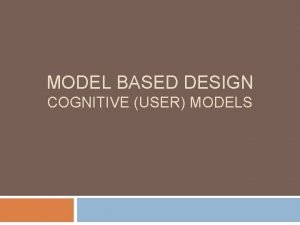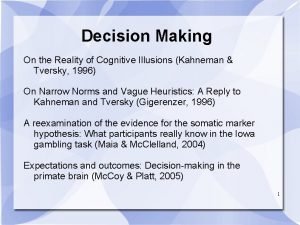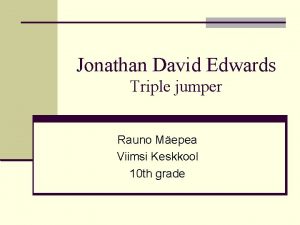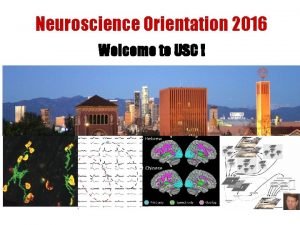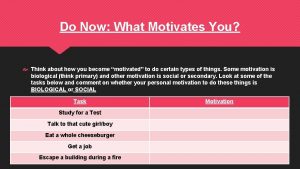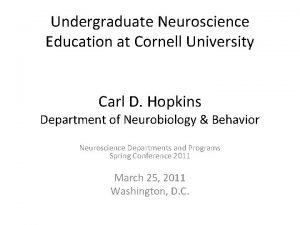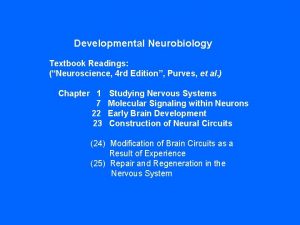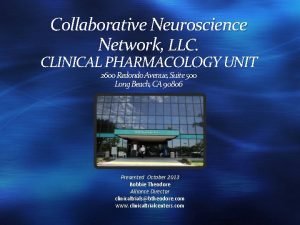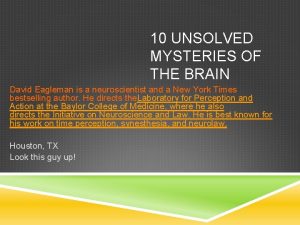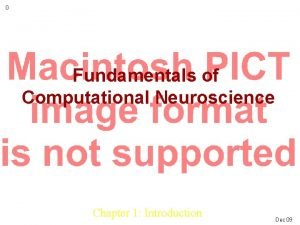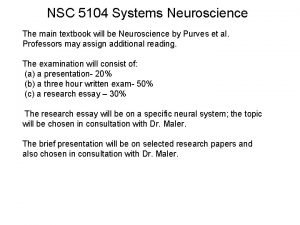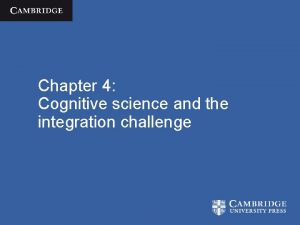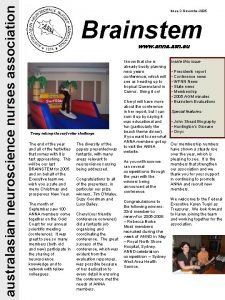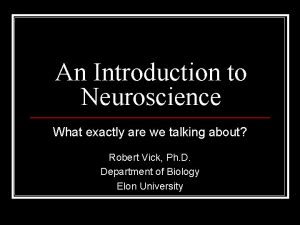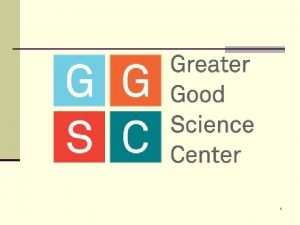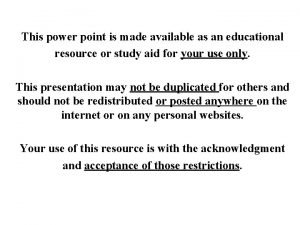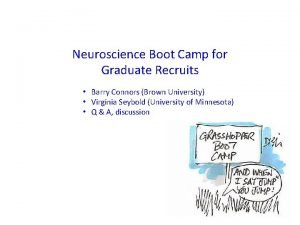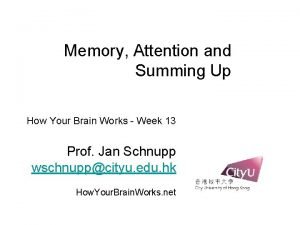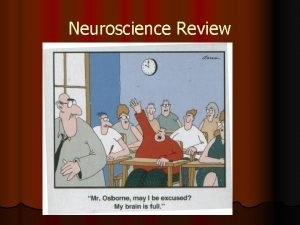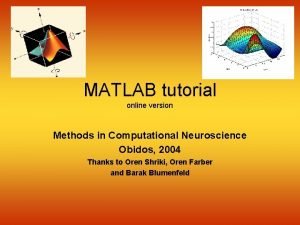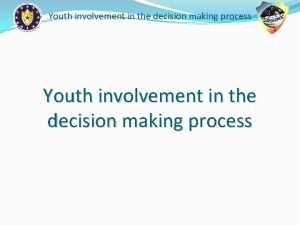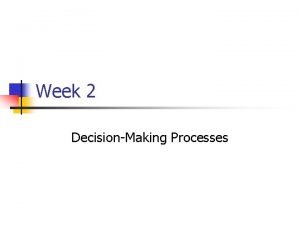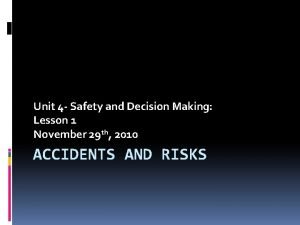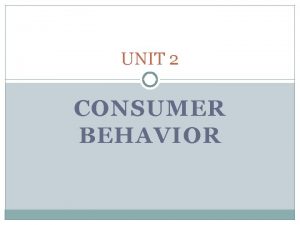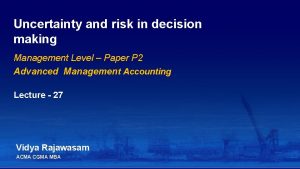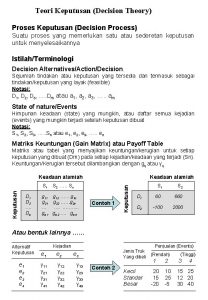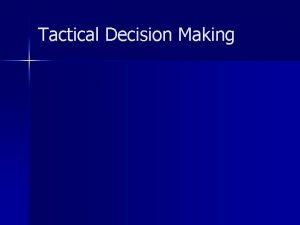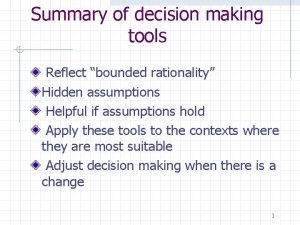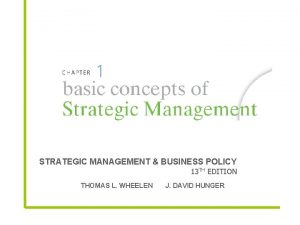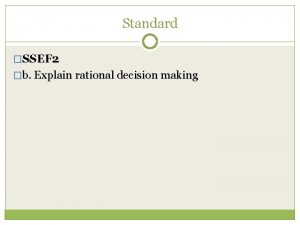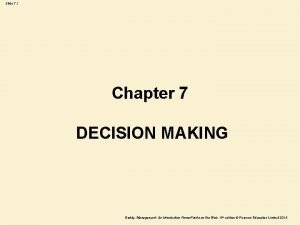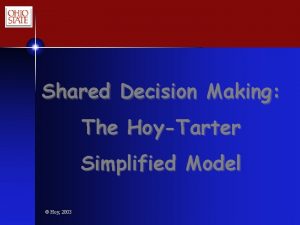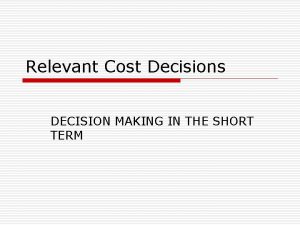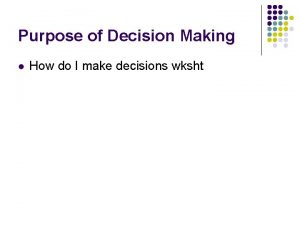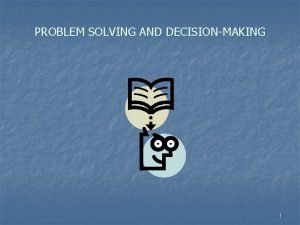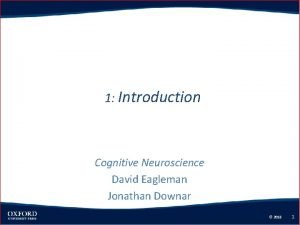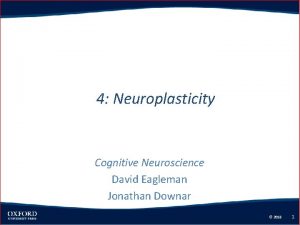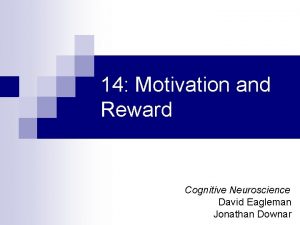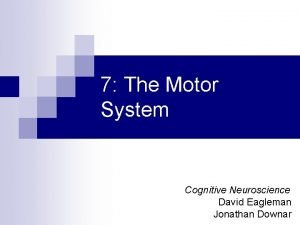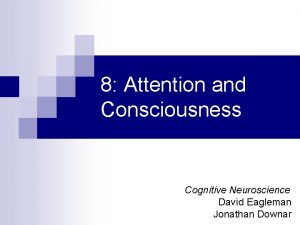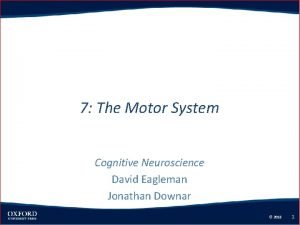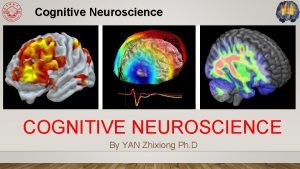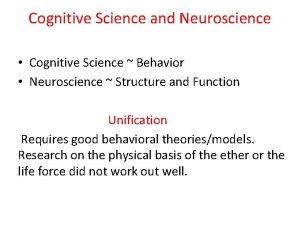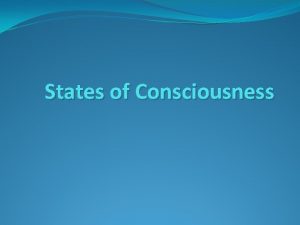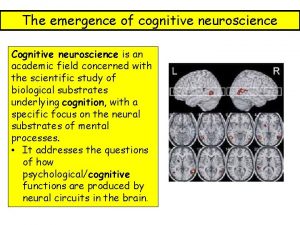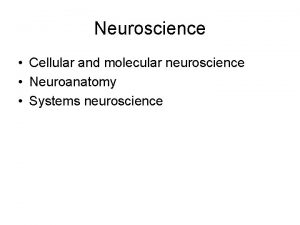12 Decision Making Cognitive Neuroscience David Eagleman Jonathan






































































- Slides: 70

12: Decision Making Cognitive Neuroscience David Eagleman Jonathan Downar

Chapter Outline How Do We Decide What to Do? n The Predictably Irrational Homo sapiens n Where Do Our Irrational Decisions Come From? n How the Brain Decides n The Common Currency of Subjective Value n A Hierarchy of Internally Guided Decision Making n Modulators of Decision Making n 2

How Do We Decide What to Do? The Scorpion and the Frog n The Search for a “Physics” of Human Decisions n Homo economicus and Rational Choice Theory n 3

The Scorpion and the Frog We make irrational decisions even though we know they are poor choices. n Recently, neuroscience has started to study decision making. n 4

The Search for a “Physics” of Human Decisions Bentham tried to develop an equivalent to Newton’s Laws of Motion for human decision making. n All actions had a “utility” or amount of happiness the action would bring to a person. n Decision making was just the act of calculating the greatest utility. n 5

The Search for a “Physics” of Human Decisions n “Felicific Calculus” ¨ Measured pleasure and pain in terms of intensity and duration. ¨ Incorporated the probability that the event would occur. ¨ Likelihood that it would be followed by more of the same or the opposite. ¨ Estimated the number of people affected. ¨ Rapidly became incalculable. 6

The Search for a “Physics” of Human Decisions 7

Homo economicus and Rational Choice Theory Modern economists still talk about the utility of a behavior. n Homo economicus is a theoretical person who always makes the same rational decisions and maximizes utility. n 8

The Predictably Irrational Homo sapiens versus Homo economicus n Confused by Uncertainty n The Framing Effect and the Endowment Effect n The Illusory Value of Procrastination n 9

Homo sapiens versus Homo economicus Homo sapiens behaves differently from Homo economicus. n Behavioral economics is the field that studies human decision making using empirical methods. n 10

Homo sapiens versus Homo economicus H. sapiens has relative preferences, which shift depending on the objects that are being compared. n H. economicus has absolute preferences, never changing regardless of the comparison. n We often get overwhelmed when there are too many choices, deciding not to decide. n 11

Homo sapiens versus Homo economicus If you are trying to decide between the sedan and the SUV, the mere presence of an inferior SUV makes the new SUV seem like a better deal and more desirable. 12

Confused by Uncertainty When confronted with a gamble with a moderate chance of success, people tend to be risk averse. n When there is a small chance of success, people tend to be risk seeking. n Framing the question so that you consider losses rather than gains makes people risk averse. n 13

Confused by Uncertainty Prospect theory describes the inconsistent behavior of H. sapiens. n A utility curve describes how people assign value to options with the prospect of a gain or loss. n The curve has a different shape for gains and losses. n There is a discontinuity at the middle of the curve. n 14

Confused by Uncertainty 15

The Framing Effect and the Endowment Effect People can be manipulated into picking a particular option, depending on how the question is set up, or framed. n If the question is framed in terms of gains, people will chose one solution. If framed in terms of loses, they will chose the other. n Framing effects are common in real-life decision making. n 16

The Framing Effect and the Endowment Effect 17

The Framing Effect and the Endowment Effect In the endowment effect, people demand a higher price to sell an object that they would pay for it. n Once they own it, it is endowed with greater value. n 18

The Illusory Value of Procrastination Rewards that occur in the future have some risk of not being collected, so are discounted. n Delay discounting reduces the value of the reward as it is payable further in the future to reflect this risk. n The delay discounting curve is quasihyperbolic. n 19

The Illusory Value of Procrastination 20

The Illusory Value of Procrastination 21

Where Do Our Irrational Decisions Come From? Decision Making in Other Species n Do Irrational Decisions Come from Irrational People? n One Brain, Two Systems n 22

Decision Making in Other Species Ultimately, decisions are the result from the nervous system, which was shaped by evolution. n The endowment effect is observed in other species. n Bonobos act like humans when evaluating risk, but chimpanzees do not. n 23

Do Irrational Decisions Come from Irrational People? One idea is that our poor decisions occur because we have a defective brain. n According to the attribution effect, we explain our own behavior by the situation, but other’s behavior is explained by their character. n The defective brain explanation is not supported by experimental evidence. n 24

One Brain, Two Systems Perhaps we have two decisional systems. n System 1 (Intuitive) n ¨ Works at a non-conscious, intuitive level. ¨ Uses parallel processing. ¨ Independent of intelligence and attention. n System 2 (Rational) ¨ Works at a conscious, explicit level. ¨ Uses sequential processing. ¨ Depends on intelligence and attention. 25

How the Brain Decides The Neural Mechanisms of Delay Discounting n Neural Mechanisms of Decisions under Risk n The Neural Basis of the Endowment Effect n The Neural Basis of the Framing Effect n 26

The Neural Mechanisms of Delay Discounting Decisions in the distant future are made rationally, but near-term decisions are made irrationally. n Different neural systems are active for decisions in the distant future vs. for decisions in the near term. n 27

The Neural Mechanisms of Delay Discounting n Areas involved in all decisions, regardless of the delay, include ¨ Dorsolateral prefrontal cortex ¨ Intraparietal cortex ¨ Supplementary motor area ¨ Presupplementary motor area ¨ Ventrolateral orbitofrontal cortex ¨ Lateral orbitofrontal cortex 28

The Neural Mechanisms of Delay Discounting 29

The Neural Mechanisms of Delay Discounting Areas involved when there was an immediate reward included medial orbitofrontal cortex, ventral striatum, and left posterior hippocampus. n When lateral areas were active, decision making resembled H. economicus. n When medial areas were active, decision making resembled H. sapiens. n 30

The Neural Mechanisms of Delay Discounting Lateral prefrontal cortex is important for suppressing irrational decisions. n Using TMS to suppress the left lateral prefrontal cortex led to more impulsive decision making. n 31

Neural Mechanisms of Decisions under Risk Different brain regions are associated with risk-seeking and risk-avoiding behaviors. n Risk taking behaviors are associated with activity in the ventral striatum and the ventromedial prefrontal cortex. n Risk aversion behaviors are associated with increased activity in the anterior insula. n 32

Neural Mechanisms of Decisions under Risk 33

Neural Mechanisms of Decisions under Risk Patients with damage to the ventromedial prefrontal cortex or the insula were more likely to gamble. n The insula seems to be associated with an aversion to taking risks. n 34

Neural Mechanisms of Decisions under Risk 35

The Neural Basis of the Endowment Effect The calculation of the value of the reward seems to involve the ventral striatum and the ventromedial prefrontal cortex. n Loss aversion seems to involve the insula. n The size of the endowment effect is correlated with the level of activity in the right insula. n 36

The Neural Basis of the Endowment Effect 37

The Neural Basis of the Framing Effect The amygdala was more active during risky options when the question was framed as a gain. n It was less active during risky options when the question was framed as a loss. n Individuals less susceptible to framing effects had more activity in ventromedial prefrontal cortex and orbitofrontal cortex. n 38

The Neural Basis of the Framing Effect 39

The Common Currency of Subjective Value Comparing Apples to Oranges n A Consistent Neural Basis for Subjective Value n Evaluation and the Orbitofrontal Cortex n One Currency, but Many Markets n 40

Comparing Apples to Oranges The brain likely uses some form of common currency when comparing two different options. n In the axiom of revealed preferences, subjects select one of two options, thereby revealing their preferences. n 41

Comparing Apples to Oranges 42

A Consistent Neural Basis for Subjective Value In the intertemporal choice paradigm, subjects assign values to rewards that occur at different times. n Medial areas are more active when choosing rewards that are smaller and occur sooner. n Lateral areas are more involved in when choosing rewards that are larger and later. n 43

A Consistent Neural Basis for Subjective Value The medial precuneus, posterior cingulate cortex, and the nucleus accumbens change their activity based on when the reward occurs. n Activity resembles quasi-hyperbolic curve. n The brain areas that track risky rewards are distinct from those that track delayed rewards. n 44

A Consistent Neural Basis for Subjective Value 45

Evaluation and the Orbitofrontal Cortex The orbitofrontal cortex receives input from all sensory modalities. n The amygdala receives sensory input and projects to the orbitofrontal cortex. n The orbitofrontal cortex projects widely throughout the brain. n The orbitofrontal cortex assembles information and assigns subjective value. n 46

Evaluation and the Orbitofrontal Cortex 47

One Currency, but Many Markets Dopamine is important for computing reward value. n There may be many places to compare the values of different options. n 48

A Hierarchy of Internally Guided Decision Making Internally and Externally Guided Decision Making n Values into Goals n Goals into Plans n Plans into Behavior and Action n 49

Internally and Externally Guided Decision Making Lateral areas, including motor and lateral prefrontal areas, use external sensory information to predict future events. n Such predictions are considered cognition. n Decision making is typically associated with internally-guided behaviors. n Conation refers to the internal processes that guide voluntary behaviors. n 50

Internally and Externally Guided Decision Making 51

Values into Goals The orbitofrontal cortex is important for assigning subjective value. n Activity in the ventral medial prefrontal cortex is associated with subject values assigned based on internal factors. n Activity in the medial frontopolar cortex is associated with subjects reflecting on their long-term goals. n 52

Values into Goals 53

Values into Goals 54

Goals into Plans Goals need to be translated into plans or strategies to describe the steps to be taken. n In the Ultimatum Game, subjects decide how to split a monetary gift with another player. n The second player can accept or reject the offer. n If rejected, neither player gets money. n 55

Goals into Plans 56

Goals into Plans Prefrontal areas are involved in deciding whether to accept or reject the offer. n Dorsal medial prefrontal areas are involved in choosing between two different types of task. n 57

Goals into Plans 58

Plans into Behavior and Action The final step in choosing a behavior is to select the specific actions to be performed to achieve the goal. n The presupplementary and supplementary motor areas are involved in controlling internally-guided movements. n 59

Plans into Behavior and Action 60

Modulators of Decision Making Strategic Use of Decision-Making Systems n Neurotransmitter Effects on Decision Making n 61

Strategic Use of Decision-Making Systems n Experimental designs involve participants making difficult moral decisions. ¨ Medial areas are more active when the subjects attempt to avoid harming others. ¨ Lateral areas are more active when the subjects attempt to do the greatest good for the greatest number of people. ¨ Frontopolar cortex is more active as the moral decisions become more challenging. 62

Strategic Use of Decision-Making Systems As subjects switch from one strategy to another, the dorsomedial prefrontal cortex changes its functional connectivity. n Increased connectivity with the amygdala and insula minimizes losses. n Increased connectivity with the dorsolateral prefrontal cortex maximizing gains. n 63

Strategic Use of Decision-Making Systems 64

Strategic Use of Decision-Making Systems n Determinants of decision making include ¨ Emotion-modulating functions of the orbitofrontal cortex. ¨ Goal-tracking functions of frontopolar cortex. ¨ Plan-selecting functions of the dorsomedial prefrontal cortex. 65

Strategic Use of Decision-Making Systems 66

Strategic Use of Decision-Making Systems 67

Strategic Use of Decision-Making Systems n Individuals with long allele of the serotonin transporter gene are less susceptible to framing effects. 68

Neurotransmitter Effects on Decision Making The neurotransmitters dopamine, serotonin, and norepinephrine are important for decision making. n Different pharmaceuticals and recreational drugs decision making. n 69

Neurotransmitter Effects on Decision Making 70
 David eagleman sleep
David eagleman sleep An introduction to model-based cognitive neuroscience
An introduction to model-based cognitive neuroscience Cognitive illusions in decision making
Cognitive illusions in decision making Objectives of decision making
Objectives of decision making Investment decision financing decision dividend decision
Investment decision financing decision dividend decision Cognitive and non cognitive religious language
Cognitive and non cognitive religious language Wiki jonathan edwards
Wiki jonathan edwards Jonathan edwards height
Jonathan edwards height Love between jonathan and david primary 6
Love between jonathan and david primary 6 Jonathan david clark
Jonathan david clark David jonathan linton
David jonathan linton David jonathan linton
David jonathan linton David jonathan linton
David jonathan linton Decision tree and decision table
Decision tree and decision table Nature neuroscience
Nature neuroscience Usc neuroscience
Usc neuroscience Dynamical systems neuroscience
Dynamical systems neuroscience Facial feedback hypothesis
Facial feedback hypothesis Cornell neuroscience undergraduate major
Cornell neuroscience undergraduate major Federation of european neuroscience societies
Federation of european neuroscience societies Developmental neuroscience textbook
Developmental neuroscience textbook Nuclei della base
Nuclei della base Collaborative neuroscience network
Collaborative neuroscience network Unsolved problems in neuroscience
Unsolved problems in neuroscience Fundamentals of computational neuroscience
Fundamentals of computational neuroscience Psy 3024 ucf
Psy 3024 ucf Systems neuroscience textbook
Systems neuroscience textbook Chess addiction treatment
Chess addiction treatment Neuroscience example
Neuroscience example Australasian neuroscience nurses association
Australasian neuroscience nurses association Neuroscience example
Neuroscience example Neuroscience psychology
Neuroscience psychology Porter neuroscience research center
Porter neuroscience research center Bg loop
Bg loop Ucsd bootcamp
Ucsd bootcamp Halle berry neuron
Halle berry neuron Jelle bruineberg
Jelle bruineberg Neuroscience afms
Neuroscience afms Matlab neuroscience tutorial
Matlab neuroscience tutorial Uw madison neuroscience
Uw madison neuroscience Youth involvement
Youth involvement Ethical assessment screen
Ethical assessment screen Systematic decision making process
Systematic decision making process What doing our country
What doing our country Mamdm
Mamdm Using recursion in models and decision making sheet 3
Using recursion in models and decision making sheet 3 Paced decision making
Paced decision making Unit 4 lesson 1 decision making
Unit 4 lesson 1 decision making How to improve marketing performance
How to improve marketing performance Types of decision making
Types of decision making Higher business corporate culture
Higher business corporate culture Contribution payoff table
Contribution payoff table Types of decision making
Types of decision making Diagnostic function of marketing research
Diagnostic function of marketing research Critical decision making
Critical decision making Contoh soal decision making
Contoh soal decision making Tactical decision making adalah
Tactical decision making adalah What is the dare decision making model
What is the dare decision making model Decision making summary
Decision making summary Mintzberg's modes of strategic decision making
Mintzberg's modes of strategic decision making Paced decision making
Paced decision making Chapter 6 prices and decision making assessment answers
Chapter 6 prices and decision making assessment answers Conditions of decision making
Conditions of decision making Sbdm committee
Sbdm committee Hoy-tarter model
Hoy-tarter model Decision making and relevant information
Decision making and relevant information 5 step decision making process
5 step decision making process Decision making in healthcare
Decision making in healthcare Abcde decision making model
Abcde decision making model Decision making in psychology
Decision making in psychology Best books on problem solving and decision making
Best books on problem solving and decision making

